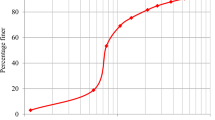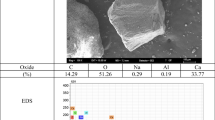Abstract
The supplanting of fine aggregate was encapsulated in this study to reduce the usage of non-renewable materials in concrete. Initially, nano–micro cementitious material (NMCM) such as metakaolin (MK) and nano silica (NS) was incorporated with Portland cement to make referral concrete (RC). An alternate for virgin river sand is crushed gravel sand (Csand) which is mostly in use. The objective of this research is to effectively supplant Csand by means of ferrochrome slag (FS). Precisely, the optimum level of MK (10%) and NS (1%) was used in place of cement. In addition, the FS was incorporated in place of Csand by 10, 20, 30, 40, 50 and 100%. A significant rise in the compressive strength of about 3.18% was achieved by replacing FS4 at 28 days than RC. Ultrasonic pulse velocity (UPV) and water permeability (WP) results of FS4 were better than those of RC. F4 was 12.5% higher in the RCPT result than for the RC specimen. The SEM image of FS4 indicates the densest calcium silicate hydrate (CSH(H)) and rigidified interfacial transition zone (ITZ). TG/DTG predicts that the FS4 mix has a minimal Portlandite (CH-3.92%) compared to RC. The strength, durability, microstructure and TG results of the FS4 matrix imply that FS can be substituted for fine aggregate.
Graphical Abstract













Similar content being viewed by others
References
Schneider M, Romer M, Tschudin M, Bolio H (2011) Sustainable cement production–present and future. Cem Conc Res 41:642–650. https://doi.org/10.1016/j.cemconres.2011.03.019
Nandhini K, Ponmalar V (2018) Microstructural behaviour and flowing ability of slef-compacting concrete using micro- and nano-silica. Micro Nano Lett 13:1213–1218. https://doi.org/10.1049/mnl.2018.0105
El-Diadamony H, Amer AA, Sokkary TM, El-Hosney S (2018) Hydration and characteristics of metakaolin pozzolanic cement pastes. HBRC J 14:150–158. https://doi.org/10.1016/j.hbrcj.2015.05.005
Jamsheer AF, Kupwade-Patil K, Buyukozturk O, Bumajad A (2018) Analysis of engineered cement paste using silica nanoparticles and metakaolin using Si NMR, water adsorption and synchrotron X-ray Diffraction. Constr Build Mater 180:698–709. https://doi.org/10.1016/j.conbuildmat.2018.05.272
Dinakar P, Manu SN (2014) Concrete mix design for high strength self-compacting concrete using Metakaolin. Mater Design 60:661–668. https://doi.org/10.1016/j.matdes.2014.03.053
Lothenbach B, Karen Scrivener RD (2011) Supplementary cementitious materials. Cem. Conc. Res. 41:1244–1256. https://doi.org/10.1016/j.cemconres.2010.12.001
Dinakar P, Sahoo PK, Sriram G (2013) Effect of metakaolin content on the properties of high strength concrete. Int J Concrete Struct Mater 7(3):215–223. https://doi.org/10.1007/s40069-013-0045-0
Escalante JI, Sharp JH (2004) The chemical composition and microstructure of hydration products in blended cements. Cement Concr Compos 26:967–976. https://doi.org/10.1016/j.cemconcomp.2004.02.036
Muhd Norhasri MS, Hamidah MS, Fadzil M (2019) Inclusion of nano metaclayed as additive in ultra high performance concrete (UHPC). Constr Build Mater 201:590–598. https://doi.org/10.1016/j.conbuildmat.2019.01.006
Vishnu A, Ponmalar V (2021) Consistency, flow, strength and durability (CFSD) assessment on concrete using superior cementitious constituents. Roman J Mater 51(1):43–52
Potapov V, Efimenko Y, Fediuck R, Gorev D (2021) Effect of hydrothermal nano silica on the performances of cement concrete. Constr Build Mater 269:121307. https://doi.org/10.1016/j.conbuildmat.2020.121307
Hongjian Du, Suhuan Du, Liu X (2014) Durability performances of concrete with nano-silica. Constr Build Mater 73:705–712. https://doi.org/10.1016/j.conbuildmat.2014.10.014
Navarro-Blasco I, Perez-Nicolas M, Fernandez JM, Duran A, Sirera R, Alvarez JI (2014) Assessment of the interaction of polycarboxylate superplasticizers in hydrated lime pastes modified with nanosilica or metakaolin as pozzolanic reactives. Constr Build Mater 73:1–12. https://doi.org/10.1016/j.conbuildmat.2014.09.052
Mondal P, Shah SP, Marks LD, Gaitero JJ (2010) Comparative study of the effects of microsilica and nanosilica in concrete. J Transport Res Board 14:12
G. Quercia, H.J.H. Brouwers, 2010 Application of nano silica in concrete Mixture https://doi.org/10.13140/2.1.1797.5044.
Supit SWM, Shaikh FUA (2015) Durability properties of high volume fly ash concrete containing nano-silica. Mater Struct 48:2431–2445. https://doi.org/10.1617/s11527-014-0329-0
Tennis PD, Jennings HM (2000) A model for two types of calcium silicate hydrate in the microstructure of Portland cement pastes. Cem Conc Res 30:855–863. https://doi.org/10.1016/S0008-8846(00)00257-X
Manigandan N, Ponmalar V (2020) Ferrochrome slag and manufactured sand as fine aggregate replacement in concrete and mortar a Brief Review. Ind J Sci Technol. 13:2657–2667. https://doi.org/10.17485/IJST/v13i26.526
Arulmoly B, Konthesingha C, Nanayakkara A (2021) Performance evaluation of cement mortar produced with manufactured sand and offshore sand as alternatives for river sand. Constr Build Mater 297:123784. https://doi.org/10.1016/j.conbuildmat.2021.123784
Shen W, Yang Z, Cao L, Cao L, Liu Yi, Yang H, Zili Lu, Bai J (2016) Characterization of manufactured sand: Particle shape, surface texture and behavior in concrete. Constr Build Mater 144:595–601. https://doi.org/10.1016/j.conbuildmat.2016.03.201
Weiguo Shen YI, Liu LC, Yang Z, Zhou C, Pengtao He Zili L (2017) Mixing design and microstructure of ultra high strength concrete with manufactured sand. Constr Build Mater 143:312–321
Raja R, Vijayan P (2021) Investigations on mechanical characteristics and microstructural behavior of laterized high strength concrete mix. Arab J Sci Eng 46:10901–10916. https://doi.org/10.1007/s13369-021-05606-7
Nanthagopalan P, Santhanam M (2011) Fresh and hardened properties of self-compacting concrete produced with manufactured sand. Cement Concr Compos 33(3):353–358. https://doi.org/10.1016/j.cemconcomp.2010.11.005
Donza H, Cabrera O, Irassar EF (2002) High-strength concrete with different fine aggregate. Cem Conc Res 32(11):1755–1761. https://doi.org/10.1016/S0008-8846(02)00860-8
Siddique S, Chaudhary S, Shrivastava S, Gupta T (2019) Sustainable utilisation of ceramic waste in concrete: exposure to adverse conditions. J Clean Prod 210:246–255. https://doi.org/10.1016/j.jclepro.2018.10.231
International Chromium Development Association (ICDA), Activity Report 2017.
Dash MK, Patro SK (2018) Effect of water-cooled ferrochrome slag as fine aggregate on the properties of concrete. Constr Build Mater 177:457–466. https://doi.org/10.1016/j.conbuildmat.2018.05.079
Manoj Kumar Dash (2018) Sanjay kumar patro, performance assessment of ferrochrome slag as partial replacement of fine aggregate in concrete. Eur J Environ Civ Eng 25:1–20. https://doi.org/10.1080/19648189.2018.1539674
Al-Jabri K, Shoukry H, Kalil IS, Nasir S (2018) Reuse of waste ferrochrome slag in the production of mortar with Improved thermal and mechanical performance. J Mater Civ Eng 30(8):04018152. https://doi.org/10.1061/(ASCE)MT.1943-5533.0002345
Zahedul Islam M, Sohel KMA, Khalifa Al-Jabri A, Harthy Al (2021) Properties of concrete with ferrochrome slag as a fine aggregate at elevated temperatures. Case Stud Const Mater. 15:e00599. https://doi.org/10.1016/j.cscm.2021.e00599
Chandru P, Karthikeyan J, Sahu AK, Ketan Sharma C (2021) Some durability characteristics of ternary blended SCC containing crushed stone and induction furnace slag as coarse aggregate. Constr Build Mater 270:121483. https://doi.org/10.1016/j.conbuildmat.2020.121483
Fares AI, Sohel KMA, Abdullah Al-Mamun K (2021) Characteristics of ferrochrome slag aggregate and its uses as a green material in concrete. Constr Build Mater 294:123552. https://doi.org/10.1016/j.conbuildmat.2021.123552
Dash MK, Patro SK, Rath AK (2016) Sustainable use of industrial-waste as partial replacement of fine aggregate for preparation of concrete. Int J Sustain Built Environ 5:484–516. https://doi.org/10.1016/j.ijsbe.2016.04.006
Karen Scrivener, (2016) A practical guide to microstructural analysis of cementitious materials, Swizerland
Borges PHR, Costa JO, Milestone NB, Lynsdale CJ, Roger E (2010) Streatfield, Carbonation of CH and C-S–H in composite cement pastes containing high amounts of BFS. Cem. Conc. Res. 40:284–292. https://doi.org/10.1016/j.cemconres.2009.10.020
Hay R, Otchere C, Kashwani G, Celik K (2021) Recycling carbonated reactive magnesium cement (RMC) as a building material. J cleaner prod 320:128838. https://doi.org/10.1016/j.jclepro.2021.128838
IS 12269:1987. R2013. Ordinary Portland Cement 53 Grade – Specification, Bureau of Indian Standards, New Delhi, India.
IS 2386–3:1963. Methods of Test for Aggregate for Concrete - part 3: Specific Gravity, Density, Voids, Absorption and Bulking, Bureau of Indian Standards, New Delhi, India.
BS EN 933–9:2010. Test for geometrical properties of aggregate : Assesement of finess Methylene blue test, British Standard Institution.
IS 10262:2009. R2019. Concrete Mix Proportioning – Guidelines, Bureau of Indian Standards, New Delhi, India.
IS 383:1970. R2016. Specification for Coarse and Fine aggregate from Natural Sources for Concrete, Bureau of Indian Standards, New Delhi, India.
IS 4925:2004. Concrete Batching and Mixing Plant – Specification, Bureau of Indian Standards, New Delhi, India.
IS 11311–1:1992. Method of Non-destructive testing of concret, Part 1: Ultrasonic pulse velocity. Bureau of Indian Standards, New Delhi, India.
IS 3805:1965. Method of Test for Permeability of Cement Mortar and Concrete. Bureau of Indian Standards, New Delhi, India.
ASTM C642:2013. Standard Test Method for Density, Absorption, and Voids in Hardened Concrete, ASTM International, West Conshohocken, PA.
ASTM C1202:2019. Standard Test Method for Electrical Indication of Concrete’s Ability to Resist Chloride Ion Penetration, ASTM International, West Conshohocken, PA.
Manu Santhanam (2019) Durability issues in concrete – Part 1. NPTEL-NOC IITM, https://www.youtube.com/watch?v=2npeWrad0TU
Nieda D, Enemark-Rasmussenc K, L’Hopital E, Skibsted J, Lothenbachb B (2016) Properties of magnesium silicate hydrate (M-S-H). Cem Conc Res 79:323–332. https://doi.org/10.1016/j.cemconres.2015.10.003
Tekina I, Dirikolu I, Gokce HS (2021) A regional supplementary cementitious material for the cement industry: Pistachio shell ash. J clean prod 285:124810. https://doi.org/10.1016/j.jclepro.2020.124810
Mannigandan N, Ponmalar V (2022) M5 investigation on ternary binder incorporated with ferrochrome slag aggregate in concrete. Appl Nano sci. https://doi.org/10.1007/s13204-022-02615-2
IS 1199–2: 2018. Fresh Concrete - Methods of Sampling, Testing and Analysis Bureau of Indian Standards, New Delhi, India.
Acknowledgements
The authors acknowledge “Anna Centenary Research Fellowships Scheme Grant No: CFR/ACRF/19131191121/AR1” of CFR, Anna University, Chennai, Tamil Nadu, India.
Author information
Authors and Affiliations
Contributions
MN: Idea, experimental work, data analysis, work conducted, original draft writing, editing and revision. PV: Data analysis, draft formation, draft editing, revision, supervision and correction.
Corresponding author
Ethics declarations
Conflict of interest
No conflicts or competing interest.
Additional information
Publisher's Note
Springer Nature remains neutral with regard to jurisdictional claims in published maps and institutional affiliations.
Rights and permissions
Springer Nature or its licensor (e.g. a society or other partner) holds exclusive rights to this article under a publishing agreement with the author(s) or other rightsholder(s); author self-archiving of the accepted manuscript version of this article is solely governed by the terms of such publishing agreement and applicable law.
About this article
Cite this article
Nagarajan, M., Vijayan, P. Some investigation on ternary powder (binder) technology incorporated with ferrochrome slag as fine aggregate in concrete. J Mater Cycles Waste Manag 25, 2822–2834 (2023). https://doi.org/10.1007/s10163-023-01710-y
Received:
Accepted:
Published:
Issue Date:
DOI: https://doi.org/10.1007/s10163-023-01710-y




